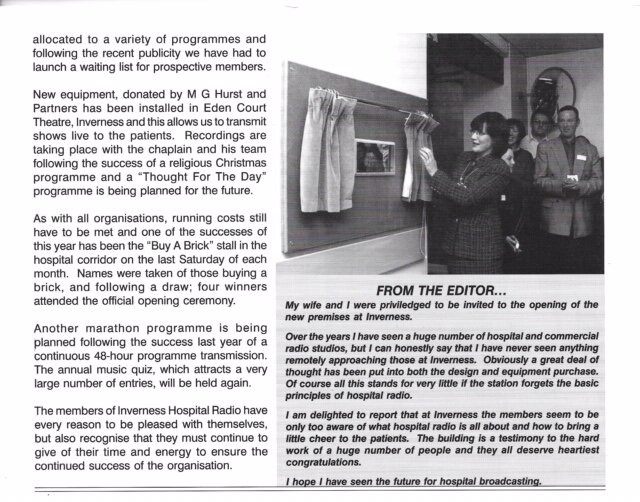
Celebrating 50 years of broadcasting
Since 2nd Nov 1970.
To celebrate, we asked Inverness Hospital Radio co-founder Donnie Aird 10 questions on the 50th Anniversary of the Station.
When you prepared the first broadcast in 1970, did you imagine that the service would still exist 50 years later?
When Alistair and I began formulating plans to set up a broadcasting service covering the then, four hospitals, in the Inverness area we had difficulty in persuading the Hospital Board Management of the viability of the plan and its sustainable future. They voiced, as an example, where the resident plumber at Raigmore had tended to and looked after a number of fish tanks in various areas of the hospital for a number of years and when he retired no one took on the responsibility for maintaining them, with the result the fish died off and the patient’s lost an amenity. They were anxious that the same could happen again if Alistair or I gave up on the project. However, it is still going strong after 50 years which, I think, is quite an achievement.
Tell us how the idea came about and how did your plans take shape?
Alistair was a part time broadcaster and contributor for BBC Highland with an interest in radio and music. I had a radio and audio business and Alistair was a customer and friend. We knew that such services had been set up in other parts of the country, so why not have one in Inverness.
I knew that a network existed whereby the hospital chaplain broadcast a short service each morning to all the wards in all the hospitals. This was done from a microphone based in the vestry of the chapel at the Royal Northern Infirmary and we were granted permission to use this facility.
The Inverness Courier did an article on our proposed service which resulted in a number of people showing an interest and volunteering their help and access to their record collections.
What sort of equipment were you using in 1970 and what problems did you have to overcome?
Our programmes in the early days were made in Alistair’s house on a Sunday morning and took ages to make. We aimed at being as professional as possible, with the result that every time we made a mistake we had to start again. We had no editing equipment in those days, so a programme was recorded straight on to a cassette machine. The telephone was taken off the hook. The door bell disconnected. Alistair’s daughter and dog locked out of the room. The music was played from the house Hi Fi unit and speech from a microphone into the recorder via a homemade mixer which I had constructed using Meccano amongst other bits and pieces.
The portable recorder was taken by myself each Monday at one o’clock to the RNI chapel and played through the chaplain’s broadcast system.
How did you go about advertising the service and getting patient requests?
Luckily we both knew and had good connections with local newspapers and their reporters throughout the North especially Alistair, who owned a number of licensed premises in the town, with the result that we achieved some good press coverage. A Post Office Box was used for requests, the number of which was published free by most Northern area papers. Among the volunteers there were those who were not interested in broadcasting but were prepared to visit wards and collect requests.
Can you tell us how the studio at the Royal Northern Infirmary became the Station’s first home and what challenges were overcome?
After some months, by which time the hospital authorities and staff could see the popularity and therapeutic benefits of the service. We approached the Hospital Board for somewhere we could set up a small studio and were allocated a store room at the RNI. This we equipped with the best professional equipment we could afford, having applied for and received grants of money from various sources. A record library was established using donated records. Requests for music that we did not have were very kindly loaned to us by The Record Rendezvous in Church Street.
During this period, a sports team had been formed, who visited football grounds on Saturday afternoons reporting live on games taking place. Another group, acquired a redundant Dennis fire engine which they transformed into a mobile public address unit attending fetes, open days etc. for a donation to the service funds.
How did it feel when the new studio at Raigmore Hospital opened, comparing it to your early days?
The move to new purpose built studios was a dream come true. Built and equipped to truly professional standards. This meant that there was space and facilities to allow the vastly increased number of members make the best use of their talents and expertise. It also meant that broadcasting hours could be increased. Our service is also used to relay services from the hospital chapel on Sunday mornings and Wednesday afternoons. This was a great improvement on our old studios at RNI.
Changes in technology and recording ( vinyl, cassette, mini Disc, CD, Digital) over the years have meant change. How has the Station adapted?
As mentioned above. The early programmes were made using domestic equipment. The music came from vinyl records which had to be carefully lined up for the particular track required. The complete one hour programme was recorded on a compact cassette, ready to be taken and played over the Chaplain’s network. On being given the room at the RNI it was equipped with a multi channel sound mixer, twin instant start turntables, reel to reel tape recorders etc. More importantly, the programmes were now going out live to the patients and not only once a week, but for three or four hours every evening as the membership grew. The advent of the CD in 1982 did not change immediately the way our music was played. CDs were expensive and we already had a comprehensive record library. Also, the majority of the requests we received were for Scottish or popular music which was slow to appear in CD format. By this time there were a few specialist programmes and the presenters of these would bring in their personal discs to play.
Shortly after the opening of Eden Court Theatre in 1976 the Service was able to get a direct music line which allowed suitable performances and shows to be broadcast live directly to the patients. This resulted in many “stars” and personalities attending the studio for interviews and even visits to the wards to meet patients, especially the children.
On the move to the Raigmore studios, CDs were now becoming the main source of music, however, a record library had to be sustained. By now we had upgraded to a PC based Record/CD b library which was a great benefit to the ward visitors as they could pre-select the patients requests, ready for the presenter.
With the rapid advance in technology and access to music online, the decision was made to invest in a digital playout system. This has meant that the Service now provides 24 hour output to our Raigmore patients.
What are your favourite memories of the Station over the last 50 years?
Too many to list here.......but some are:
Setting up the first studio at the RNI.
Doing programmes with members no longer with us.
Opening of the Raigmore studios with Lorraine Kelly,
Receiving the Queen’s Award for Voluntary Service.
Attending the Queen’s 80th Birthday Celebrations in London on behalf of the service.
When we had entries in the River Ness Raft Races.
Do you have a funniest moment over the years that you can share with us?
When Ronnie Corbett refused to let me interview him at Eden Court. The Press & Journal got wind of this and resulted in a headline next day making me out as the Bad Guy!
The Station is now looking to move to online broadcasting next year.....what are your thoughts on that?
Initially the service had a captive audience. Most of the wards were quite large where the patients, especially the orthopaedic wards, would form a collective audience with requests, comments and banter to each other over our programmes. Also, patients remained in hospital for longer periods then, some for months at a time. This changed over the years as the number of hospitals was reduced until only Raigmore was left. Patient stay in hospital is now mostly for days, or in some cases hours. They also have bedside television and other radio stations available, mobile phones and personal CD players. This has reduced our listening numbers.
For the service to survive, it has got to keep pace with other media and entertainment developments, therefore the way forward is obviously to move to online broadcasting. This will not only keep us serving Raigmore hospital, but has the potential to expand our broadcasts to other hospitals and institutions in the Highland Health Board Area.
IHR: Over the Years
Explore snapshots of Inverness Hospital Radio over the years below.
Lorraine Kelly presenting Terry Henderson with his 15 year service award












